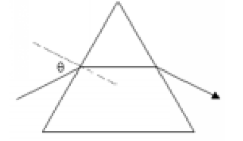A ray of light enters an equilateral prism made of material with n = 1.45 at an angle of incidence  The internally refracted ray is parallel to the base of the prism. What is the angle of refraction for the ray leaving the prism?
The internally refracted ray is parallel to the base of the prism. What is the angle of refraction for the ray leaving the prism?

A. 46.5
B. 30.0
C. 20.2
D. 15.7
E. the ray won't leave the prism
A. 46.5
You might also like to view...
Interstellar extinction and the reddening of light by the interstellar medium (ISM) are both caused by _____
a. atoms and molecules in the ISM b. only atoms in the ISM c. only molecules in the ISM d. only dust in the ISM e. dust, atoms and molecules of the ISM
Given that life on Earth appears to have arisen quite easily and rapidly suggests that the factor flife, in the Drake equation could be close to
A) 1 B) 0.25 C) 0 D) 0.5
A converging lens will cause parallel rays of light to
A. Bend to meet at the focal point of the lens. B. Remain parallel C. Bend as though coming from the focal point of the lens. D. Scatter in random directions.
A flat coil having 160 turns, each with an area of 0.20 m2, is placed with the plane of its area perpendicular to a magnetic field of 0.40 T
The magnetic field changes uniformly from 0.40 T in the +x direction to 0.40 T in the -x direction in 2.0 s. If the resistance of the coil is 16 ?, at what rate is power generated in the coil during this change? A) 5.0 W B) 10 W C) 15 W D) 20 W